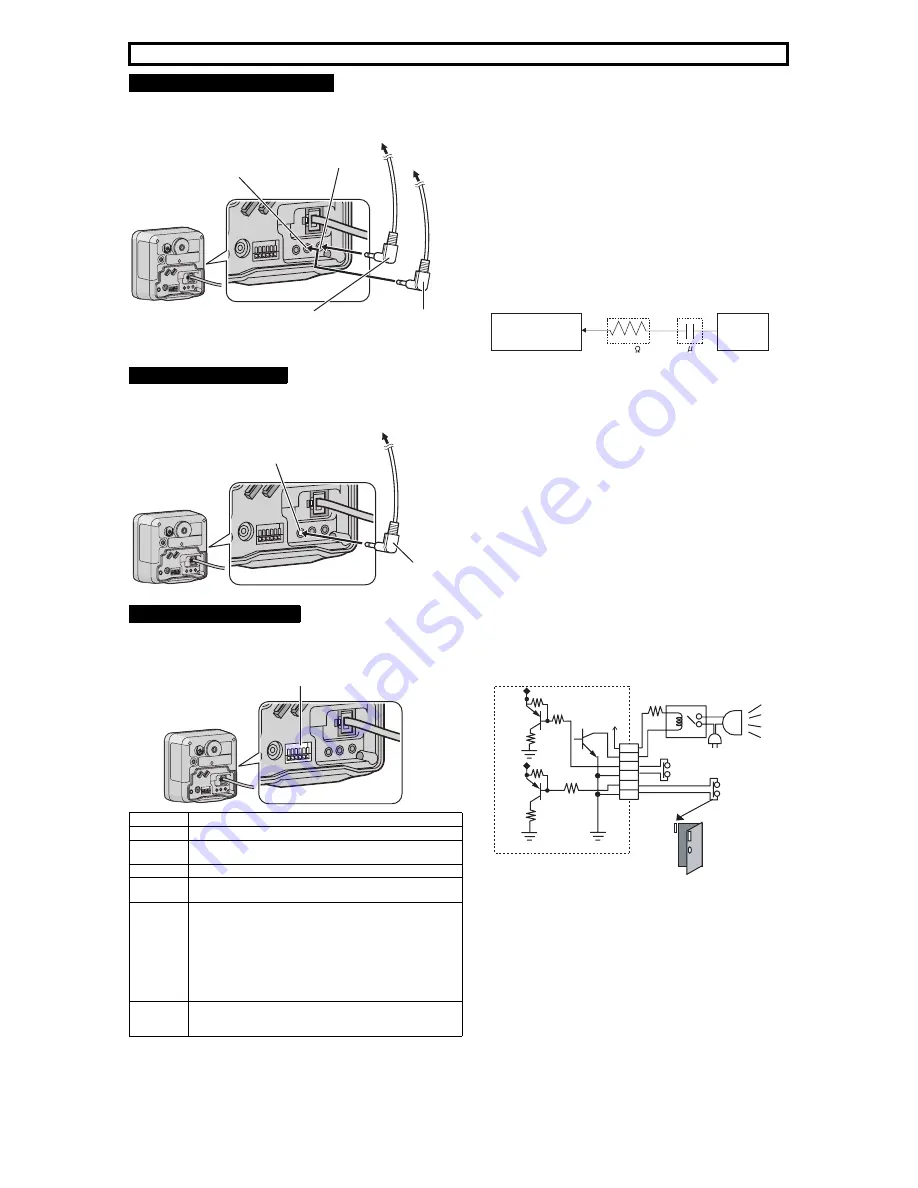
3
You can connect an external microphone and external speaker to the camera to use the Listen and Talk features, respectively. For information about these
features, see 1.2.9 Audio Features in the Operating Instructions on the CD-ROM. Connect the devices as shown below.
You can connect a TV or other video device (NTSC or PAL format) to the camera to monitor or record camera images. Connect the video device as shown
below.
The camera’s external I/O interface allows you to connect 2 devices (such as sensors, motion detectors, etc.) that can be used to trigger the camera’s image
buffering and transferring features (see Section 2 Using Triggers to Buffer and Transfer Images in the Operating Instructions on the CD-ROM).
The external I/O interface has 6 terminals.
Connecting External Audio Devices
Note
• If you use an external microphone, excessive cable length or a poor
quality cable can cause degradation in audio quality.
• The microphone cable should be no longer than 7 m (23 feet).
• Use a speaker with a built-in amplifier. The speaker connects to the
camera with a stereo audio cable similar to that used by your PC. The
output signal is mono.
• Make sure the camera and speaker are turned off when connecting or
disconnecting the speaker cable, otherwise noise may be heard from
the speaker.
• The external microphone input does not correspond to a line level.
Audio may be distorted when the line level is input. Audio distortion will
be solved if you insert the following circuits. Under no circumstance
should high-level audio, such as from a speaker, be connected to this
input terminal. Doing so is likely to damage the camera.
Connecting a Video Device
Note
• Analog video output is disabled by default. See 7.5 Controlling the
Analog Video Output Signal in the Operating Instructions on the CD-
ROM for more information.
Connecting External Sensors
Circuit Diagram Example
Caution
• The external I/O interface is not capable of connecting directly to
devices that require large amounts of current. In some cases, a custom
interface circuit (customer-provided) may have to be used. Serious
damage to the camera may result if a device that exceeds its electrical
capability is connected to the external I/O interface.
• Low voltage/current circuits and high voltage/current circuits are used
in the camera circuit. All wiring should be performed by a qualified
electrician. Incorrect wiring could damage the camera and cause a fatal
electric shock.
• External devices connected to the camera’s output terminals cannot be
controlled in the event of a network error or failure. Keep this in mind
when connecting door locks, heat-emitting devices, or other devices
that may be dangerous if they cannot be controlled.
Terminal
Description
G
GND terminal.
1
External sensor input 1. The camera can be triggered by either an open
circuit or a GND short-circuit.
G
GND terminal.
2
External sensor input 2. The camera can be triggered by either an open
circuit or a GND short-circuit.
3
External device control output. Allows you to control an external device
using the output buttons in the camera’s operation bar (for example,
turning a light on or off).
• This terminal’s behavior can be changed (see 7.4 Controlling the
External Output Terminal in the Operating Instructions on the CD-
ROM).
• This terminal is an open collector circuit. The maximum drawing
current is the same as terminal 4. Do not exceed the voltage of the
terminal 4.
4
DC power output terminal.
• 10.5–13 V DC
• Maximum load drive is 100 mA.
Note
• Do not push strongly on the external I/O interface with the pointed object.
The external I/O interface may get stuck into the unit, and you may not be
able to use it.
To microphone
For speaker
(Output impedance
560
Ω
line level)
For microphone
(Plug-in power +3.3 V)
Microphone cable
(
φ
3.5 mm plug)
Speaker cable
(
φ
3.5 mm stereo
plug)
To speaker
Camera
Microphone Input
Audio Line
Out
Capacitor
Resistor
1 F
33 K
For video device
To video device
Video cable
(
φ
3.5 mm plug)
External I/O interface
Light
Door Sensor 1 (Alarm 1)
Door Sensor 2 (Alarm 2)
Relay
Camera
12 V*
2
3
4
G
1
G
*DC 10.5 V–13 V
Read the following information after setting up the camera according to the procedure described in the Setup Guide.




